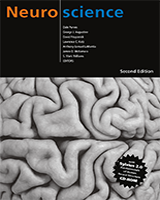By agreement with the publisher, this book is accessible by the search feature, but cannot be browsed.
NCBI Bookshelf. A service of the National Library of Medicine, National Institutes of Health.
Purves D, Augustine GJ, Fitzpatrick D, et al., editors. Neuroscience. 2nd edition. Sunderland (MA): Sinauer Associates; 2001.

Neuroscience. 2nd edition.
Show detailsThe distribution of rods and cones across the surface of the retina also has important consequences for vision (Figure 11.10). Despite the fact that perception in typical daytime light levels is dominated by cone-mediated vision, the total number of rods in the human retina (91 million) far exceeds the number of cones (roughly 4.5 million). As a result, the density of rods is much greater than cones throughout most of the retina. However, this relationship changes dramatically in the fovea, a highly specialized region of the central retina that measures about 1.2 millimeters in diameter (Figure 11.11). In the fovea, cone density increases almost 200-fold, reaching, at its center, the highest receptor packing density anywhere in the retina. This high density is achieved by decreasing the diameter of the cone outer segments such that foveal cones resemble rods in their appearance. The increased density of cones in the fovea is accompanied by a sharp decline in the density of rods. In fact, the central 300 µm of the fovea, called the foveola, is totally rod-free.

Figure 11.10
Distribution of rods and cones in the human retina. Graph illustrates that cones are present at a low density throughout the retina, with a sharp peak in the center of the fovea. Conversely, rods are present at high density throughout most of the retina, (more...)

Figure 11.11
Diagrammatic cross section through the human fovea. The overlying cellular layers and blood vessels are displaced so that light rays are subject to a minimum of scattering before they strike the outer segments of the cones in the center of the fovea, (more...)
The extremely high density of cone receptors in the fovea, and the one-to- one relationship with bipolar cells and retinal ganglion cells (see earlier), endows this region (and the cone system generally) with the capacity to mediate high visual acuity. As cone density declines with eccentricity and the degree of convergence onto retinal ganglion cells increases, acuity is markedly reduced. Just 6° eccentric to the line of sight, acuity is reduced by 75%, a fact that can be readily appreciated by trying to read the words on any line of this page beyond the word being fixated on. The restriction of highest acuity vision to such a small region of the retina is the main reason humans spend so much time moving their eyes (and heads) around—in effect directing the foveas of the two eyes to objects of interest (see Chapter 20). It is also the reason why disorders that affect the functioning of the fovea have such devastating effects on sight (see Box C). Conversely, the exclusion of rods from the fovea, and their presence in high density away from the fovea, explain why the threshold for detecting a light stimulus is lower outside the region of central vision. It is easier to see a dim object (such as a faint star) by looking away from it, so that the stimulus falls on the region of the retina that is richest in rods (see Figure 11.10).
Another anatomical feature of the fovea (which literally means “pit”) that contributes to the superior acuity of the cone system is that the layers of cell bodies and processes that overlie the photoreceptors in other areas of the retina are displaced around the fovea, and especially the foveola (see Figure 11.11). As a result, light rays are subjected to a minimum of scattering before they strike the photoreceptors. Finally, another potential source of optical distortion that lies in the light path to the receptors—the retinal blood vessels—are diverted away from the foveola. This central region of the fovea is therefore dependent on the underlying choroid and pigment epithelium for oxygenation and metabolic sustenance.
- Anatomical Distribution of Rods and Cones - NeuroscienceAnatomical Distribution of Rods and Cones - Neuroscience
Your browsing activity is empty.
Activity recording is turned off.
See more...